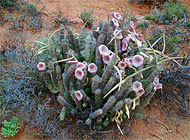
© Nico Laubscher CITES Photo Gallery
On this page:
- Introduction
- What It Is Used For
- How It Is Used
- What the Science Says
- Side Effects and Cautions
- Sources
- For More Information
Introduction
This fact sheet provides basic information about the herb hoodia—common names, uses, potential side effects, and resources for more information. Hoodia is a flowering, cactus-like plant native to the Kalahari Desert in southern Africa. Its harvest is protected by conservation laws.
Common Names—hoodia, Kalahari cactus, Xhoba
Latin Names—Hoodia gordonii
What It Is Used For
- Kalahari Bushmen have traditionally eaten hoodia stems to reduce their hunger and thirst during long hunts.
- Today, hoodia is marketed as an appetite suppressant for weight loss.
How It Is Used
- Dried extracts of hoodia stems and roots are used to make capsules, powders, and chewable tablets. Hoodia can also be used in liquid extracts and teas.
- Hoodia products often contain other herbs or minerals, such as green tea or chromium picolinate.
What the Science Says
There is no reliable scientific evidence to support hoodia's use. No studies of the herb in people have been published.
Side Effects and Cautions
- Hoodia's safety is unknown. Its potential risks, side effects, and interactions with medicines and other supplements have not been studied.
- The quality of hoodia products varies widely. News reports suggest that some products sold as hoodia do not contain any hoodia.
- Tell your health care providers about any complementary and alternative practices you use. Give them a full picture of what you do to manage your health. This will help ensure coordinated and safe care.
Sources
- Hoodia. Natural Medicines Comprehensive Database Web site. Accessed on May 16, 2007.
- Hoodia (Hoodia gordonii). Natural Standard Database Web site. Accessed on May 16, 2007.
NCCAM Clearinghouse
The NCCAM Clearinghouse provides information on CAM and NCCAM, including publications and searches of Federal databases of scientific and medical literature. The Clearinghouse does not provide medical advice, treatment recommendations, or referrals to practitioners.
Toll-free in the U.S.: 1-888-644-6226
TTY (for deaf and hard-of-hearing callers): 1-866-464-3615
Web site: nccam.nih.gov
E-mail: info@nccam.nih.gov Contact NCCAM
CAM on PubMed
Web site: nccam.nih.gov/camonpubmed/
NIH Office of Dietary Supplements
Web site: ods.od.nih.gov
This publication is not copyrighted and is in the public domain. Duplication is encouraged.
NCCAM has provided this material for your information. It is not intended to substitute for the medical expertise and advice of your primary health care provider. We encourage you to discuss any decisions about treatment or care with your health care provider. The mention of any product, service, or therapy is not an endorsement by NCCAM.
NCCAM Publication No. D387
Created August 2007
Updated June 2008